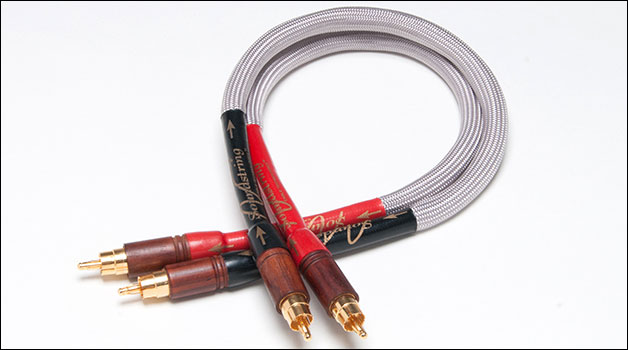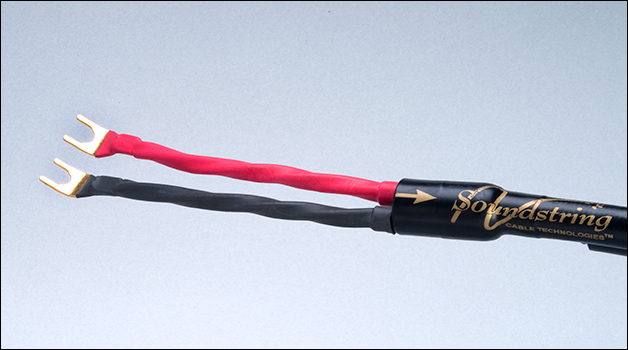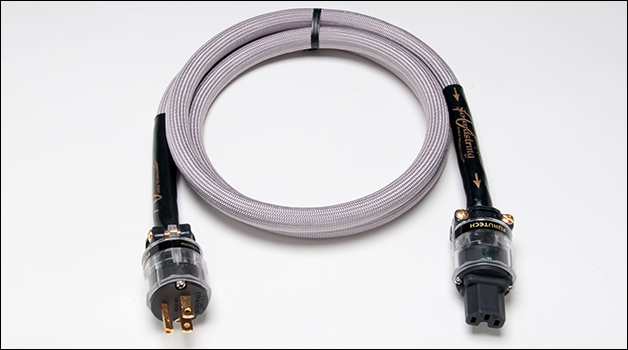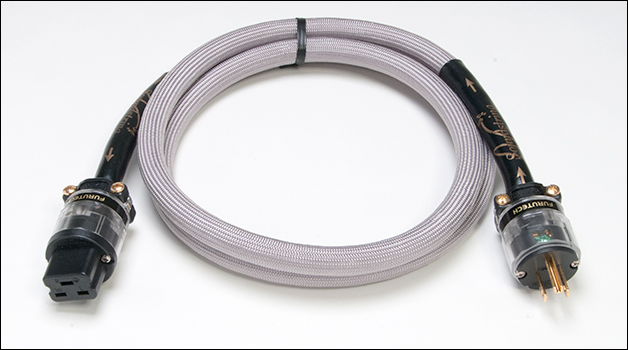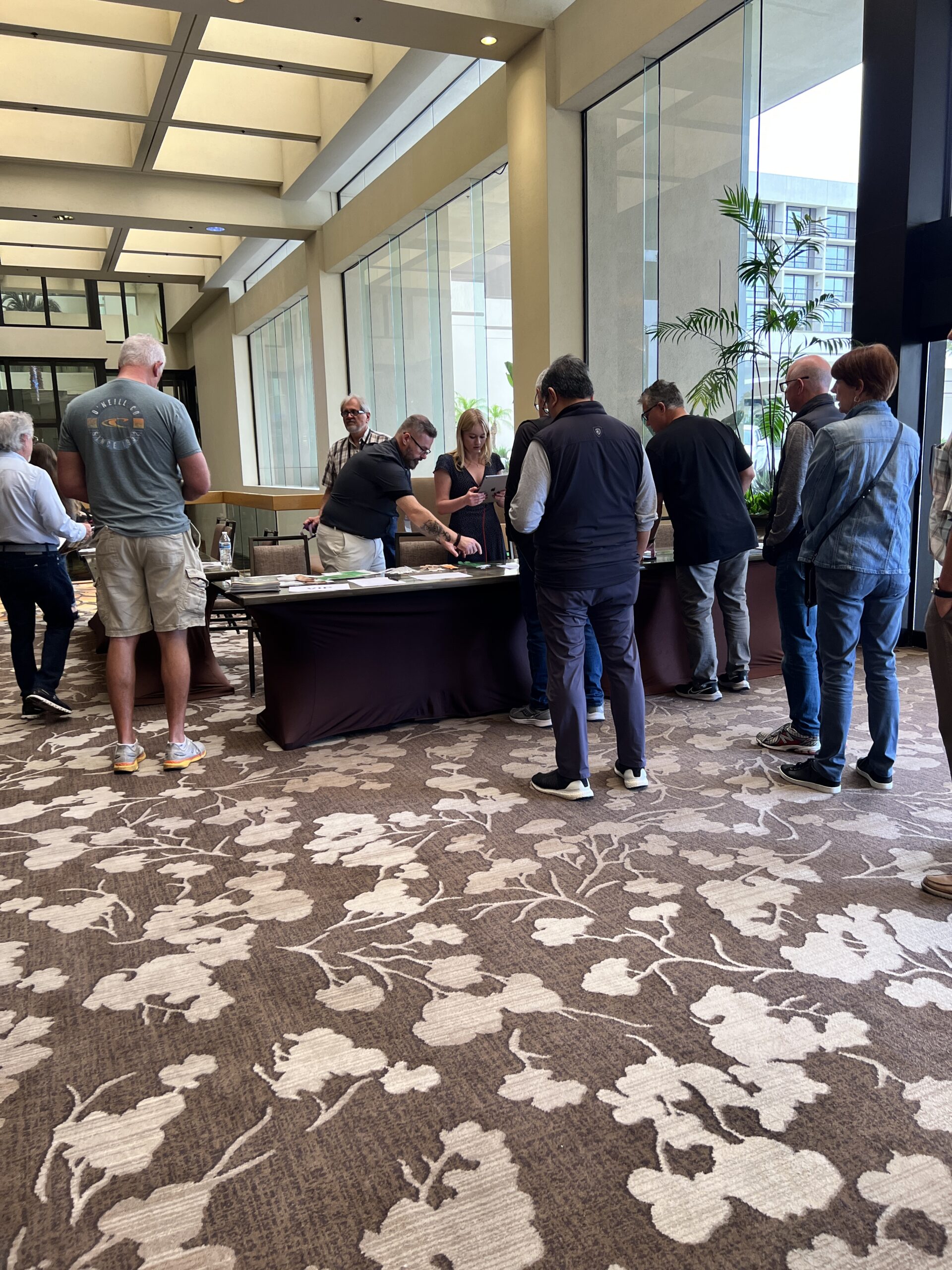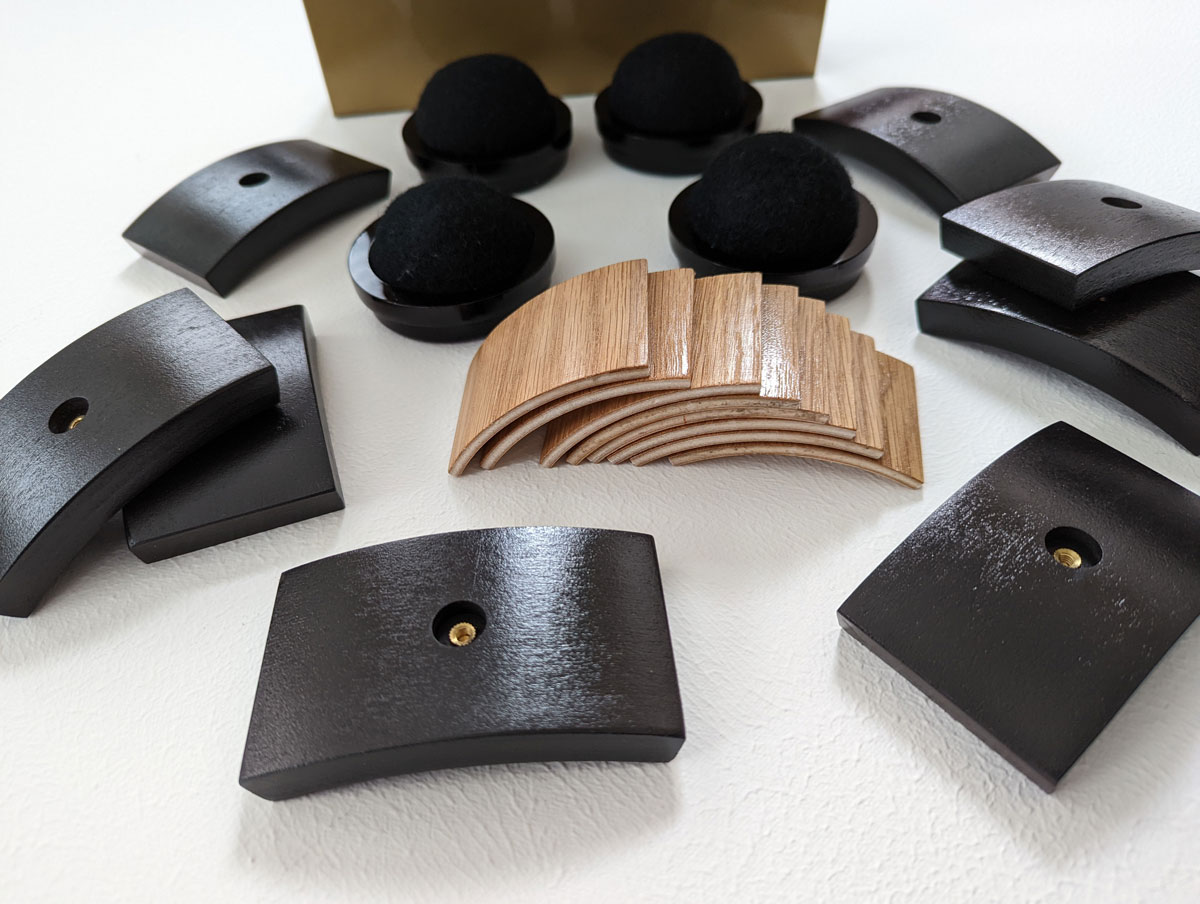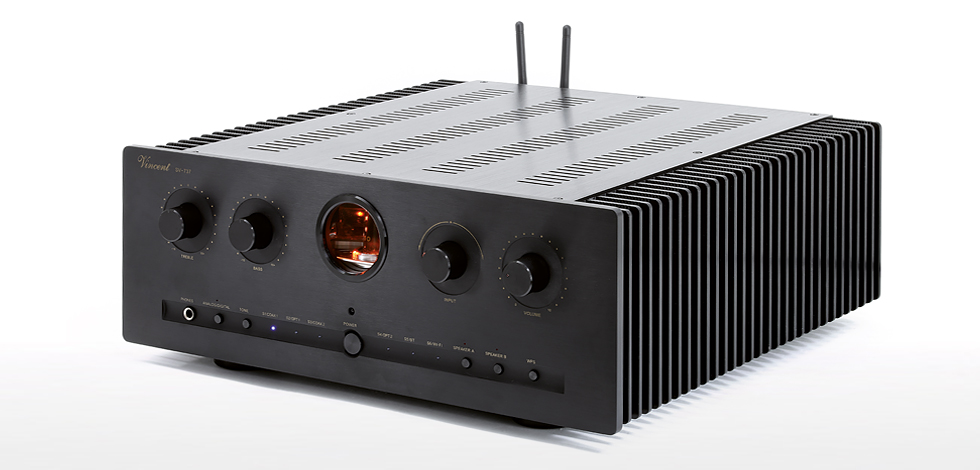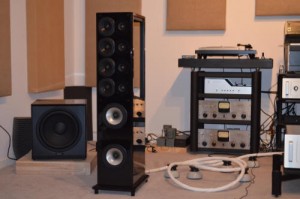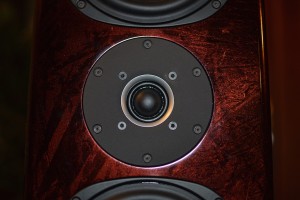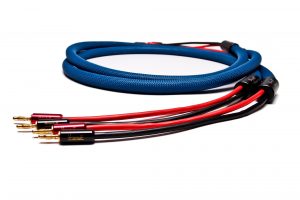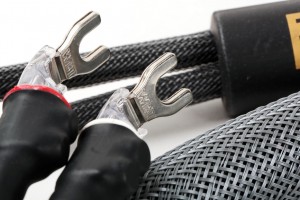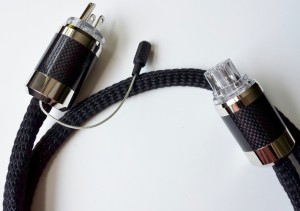Talk about the proverbial can of worms. Recently Soundstring Cable Company's Len Miller asked if I would like to review two full complements of wire from their new line of cable. Whoa, that is a lot of cable. I have heard of hard core audio reviewers who refuse to do wire reviews. So either I am crazy, a little hasty in my decision to accept this review, or look forward to one heck of a challenge. How about a little of all three? Needless to say I said yes. The cables that were sent to me consist of their Gen II and Gen II SE (Special Edition) cables. This included two 3 ft. SS- Gen II Beta 2-22 non-shielded single ended interconnect cables with Cocobolo wood housings, one 8 ft. pair of Gen II Gamma Standard speaker cable with gold plated spades on all ends, two 6 ft. and one 5 ft. Gen II Delta 3-12 high output 30 amp power cords with Furtech male and female plugs, one 6 ft. and one 4 ft. Gen II Digimax 18 low output 10 amp Digital power cords with Furtech male and female plugs. That is just one set. The second set is the Gen II Platinum Series Special Edition cables. It consisted of the same quantity and dimensions of cable only in the SE Platinum edition. The SE Platinum cables differ from the Gen II in that they are built with "Enhanced Conductors" and "98% non-metallic RFI/EMI Braid Shield." Soundstring says that this shielding "greatly improves protection against all types of "RF" and "EM" interference. The speaker cables are also equipped with "8mm gold plated spade terminals". The Gen II SE line differs also from the regular Gen II Delta not only with the shielding mentioned above, but each cable is said to have enhanced strand counts in the individual conductors resulting in a larger area for current to travel through. The Gen SE II power cables, which also use the nonmetallic EMI/RFI braid shielding, are made with Furtech plugs, are high output UL approved, and can be used in a 110-120 volt AC dedicated electrical service from a circuit breaker, as well as power cord applications. There are many configurations that this power cord cable can be utilized for, including international applications. The SE version of Soundstring interconnects are not available yet due to re-designing of the Cocobola wood housings. The RCAs that are on the Gen II Beta 2-22 interconnects are Soundstring's own patented design called "Ultra Low Mass," and are crimped on. They also feature a polished Cocobolo natural wood outer shell." The copper is 6-9's oxygen free high conductivity electrolytic bare copper and are #22 AWG overall. The outer covering (for all Gen II Delta and Gen II SE wire) is a Platinum Silver color nylon multi-filament jacket. I have had and continue to use non-shielded interconnects in my system without interference or noise pick up of any kind. Len Miller also asked me if I would like to listen to their shielded interconnects, but I declined. Needless to say these cables are built to a very high standard. In the years I have used my Soundstring cables, I have never had one bit of failure or problems with them. I don't know about you, but to me that is a very big plus, especially with as much switching of cables and gear that I do in my system.
So the big difference in design between the two sets of wire is more copper per cable and better shielding. Sounds fair. But please don't take this as an over-simplification on my part. Soundstring says that their cables, through the years of R&D, form an "evolutionary pathway of least resistance" in signal and frequency transfer and voltage control. They also hold several patents for high performance power supply, audio and interconnect cables. Their website will have a more comprehensive definition of their products than I can provide here. I have touched on a few important points concerning these cables. There is indeed a wealth of information on their products there. In the cable world, they are definitely a company to be reckoned with. I might add that Soundstring cables have impeccable build quality, are flexible enough to easily work with, and are built with pleasing colors. Also on their website there is a very interesting section labeled, Picture Library-Manufacturing. Here you will find out the history of the company and some very impressive pictures of their manufacturing process. I was very impressed with this.
Soundstring cable is no stranger to my system. I have used their Tricormaxial speaker cables, interconnects, and power cords over the years. I use them with a variety of cables from other vendors. You could say that I have a mix and match approach to wiring up my system. So needless to say I was doubtful as to how I was going to approach this review. Along with the wire in my system, and the two sets from Soundstring, I had my work cut out for me. I thought of changing out one full set of wire, taking notes, then changing out a second set. This sounded easier than it actually is. The vice grip of the BPT power conditioner made it very hard to pull the power cords from its receptacles. Not to mention it is in an awkward position behind one of my speakers. The speaker cables have spades on them instead of Z-plugs, which took longer to change out on the WBT style posts on my amp and speakers. And since my stereo rack is held down by spikes and doesn't roll, it was a matter of bending my big, aging body around the back of that thing, with a mirror in one hand, cable in the other, and positioning my head to direct the light from my hard hat light (without the hard hat) to the right input on the very tightly spaced inputs on my Marantz integrated amp. One other important factor that dissuaded me from this approach is that I kept thinking that my aural memory is not going to hang on as long as it takes to do all of this. Taking into account the time I sit on the couch and catch my breath. I need it quiet so the heavy breathing is not welcome. So I decided that changing out one cable for one was the best approach. Interconnect for interconnect, power cable for power cable and of course speaker cable for speaker cable. One more thing about both sets of these wires, except the thickness looks exactly the same. They are not clearly marked Gen II Delta and Gen II SE. This made it very frustrating when trying to make quick comparisons. If it had not been for me marking them with some Avery labels from the start, it would have been a nightmare. Even though they differ slightly in thickness, it is hard to distinguish them. The Digital cords were especially close in my slightly darkened den.
Before we get started, I am going to go out on an audiophile limb for a minute. In the hierarchy of a stereo system, I feel the most important thing one could do to one's own system is feed it with great quality recordings. This will improve the sound quality of even the most modest of high end systems. This is a great thought but fraught with pitfalls. If all music was recorded impeccably we would all be in musical nirvana. But sadly this is not the case. Especially with the current loudness wars raging in the studios. Secondly, what music is finely recorded might not suit ones taste in music. Who was it who said that a stereo system is only as good as the worst recording it can reproduce, or something like that. Next is room treatment. The little I have done to my room has improved the sound in remarkable ways. This is something most of us seem to ignore. What's left is the hardware, tweaks and finally wire. Wire is sometimes treated as an afterthought with some audiophiles I have talked to. To me it is just as important as everything else in one's system. Until wireless systems are the norm, good quality, well-built wire is essential to our systems. There were times when I had heard very little differences when comparing power amplifier, preamps, and especially CD players. But they were there. Some people say that wire is wire and there is little difference if any between two pieces. There have been times when I have heard very small differences between very expensive wire and inexpensive wire. And there were times when the differences almost popped out at you regardless of price. Soundstring cables are built to a high standard in the USA, are affordable in high end cable standards, and actually have a factory that produces them. I will say that in comparisons with the two lines they sent me, and my own varied wire, I sometimes heard clear and distinct differences and there were other times when the differences were not so large. And that was from wire that was sometimes more expensive and sometimes less expensive than the Soundstring. Needless to say it was a very interesting ride. So without further ado let's get to the listening tests. And please let's have some fun!
The music I picked for this review was picked not only for sound quality but for its musical worth to me. These CDs are from the blues and rock genre. I did not pick any classical works due to their very slow as syrup starting times. This does not work for spontaneous and quick listening comparisons. The Joe Bonamassa CD Blues Deluxe, Carlinhos Brown, A Gente Ainda Nao Sonhou, and Doug MacLeod, You Can't Take My Blues were the primary CDs played to evaluate the wires. But many CDs, LPs DVDs and Blue Rays saw action on my two Marantz spinners with this review.
I chose to use my Marantz PM15S1 integrated amplifier and SA15S2 SACD player both of which have the full signature modifications from the Upgrade Company. These two units are very revealing yet very musical. My reasoning was also of a practical nature. Unlike my Wyred4Sound mono amps and preamplifier, there would be less wire to change out in the Marantz system. Len Miller also told me that all of the cables he sent me were burned in on the Audiodharma Anniversary Edition 3 cable cooker with 120 hours before they were shipped to me. He also mentioned that an additional 24-48 hours of system time could be put on them for the completion of break in. Those additional hours would be easy to add up in my system.
First up was the speaker wire. I compared my Soundstring Tricormaxial with the new Gen II SE Gamma speaker cable. Easily noticeable was the degree of soundstage dimension that was reduced with the old wire. The placement of images and the space between them was not as transparent. I also noticed a slight reduction in dynamics as well. The differences were easily noticeable. Inserting the Gen II SE Gamma 4/12 wire instantly revealed a more open soundstage. Images were more cleanly defined as was the space between them. On Joe Bonamassa's acoustic guitar the dynamics and dynamic shading took on a more solid, yet nuanced sound. Bass sounded powerful yet tuneful and articulate. I was surprised because the Tricomaxial is a 4/12 design as is the Gen II SE Gamma. That is both wires are built from 4 conductors, 12 gauge wires. Yet the differences were clearly heard. I no longer have the Tricormaxial digital cables or interconnect so I could not do a comparison with the new cables.
Next up was a comparison between the SE Gen II Gamma and Gen II Delta standard speaker cables. The Delta are a 12/2 design. They are a very clean and spacious speaker cable with very good dynamics. Details are clean and images are clearly defined. Replacing them with the SE I clearly heard a tighter grip on bass and dynamics which could be heard on the congas, drums, and bass guitars on the Carlinos Brown CD. Vocal images and dynamic shadings clearly sounded more realistic in regard to their image in the soundstage. Separation of instruments and images were much easier to make out. With the Gen II SE speaker wire I felt as if the space around the instruments was enhanced and very realistic.
I have several different sets of interconnects in my personal wire stash from various manufacturers. I compared the Soundstring Gen II Beta non shielded single ended interconnect to a few I have. First of all, what I like about the Soundstring's unshielded interconnects, besides their build quality, is that for the most part they just get out of the way. It is hard to describe the sound of something like this. But let's say that these interconnects "sound" very balanced from top to bottom. They have solid bass, clean midrange, and clean and extended upper ranges. I did not hear any unwanted anomalies in the top end, such as undue harshness or sibilance. Neither did I hear exaggerated bloat in the bass. Image and soundstage performance are also very good. After listening to them I replaced them with my pair of Analysis Plus Solo Crystal Oval interconnects. The APs proved a very interesting comparison. They exhibit a very solid soundstage and images with clear and clean natural timber. I feel the AP cable to be very grainless and ever so slightly sweeter sounding, if you will, than the Soundstring Gen II Delta, which I feel is due to their grainless nature. These two cables were very close in performance. But I ultimately felt that the APs were my preferred cable. They were so close that I am sure the outcome may be different in a different system. It will also be interesting to compare them to Soundstring's Gen II SE interconnect when they come out.
I then switched out the APs for a pair of 6/9's pure copper unshielded twisted pair of interconnects from Tonian Labs. These interconnects match the speaker cable from this company in construction and material. The Tonian Labs cable is also a very clean, detailed, and dynamic cable. I found them to be noticeably more extended in the top end. This surprised me. This type of performance characteristic was a double-edge sword in my system. The Bonamassa CD now sounded too extended in the top octaves if you know what I mean. Reinserting the Soundstring Gen II Delta interconnects the sound became fuller, slightly less incisive, and easier to listen to. I also compared the Tonian Labs pure copper twisted pair speaker wire with both Soundstring speaker wires. Again I was surprised by this cables performance. The sound became slightly thicker overall, both tonally and spaciously. Instead of mirroring the sound of its stablemate interconnects.
The biggest surprise with all of this wire had to be with the power cords. At first I did not think there would be much difference between my reference cords and the Soundstring power cords. We have all heard the objective argument of what difference would a few feet of fancy wire make when it travels many miles through the wire that the power companies use to get it to you. And believe me the wire the power companies use is not fancy by any means. I know, I work for one of those power companies. But that is exactly the point and there could lie the very differences. The Soundstring power cords are constructed differently than plain old aluminum triplex. In the case of the Soundstring power cords, it is in the fine metals in the Furtech connectors with 24 kt. gold plated contacts, the 98% non-metallic RFI/EMI braid shielding and the 6-9's pure oxygen free copper.
First up was my old Soundstring Tricormaxial power cord versus the Gen II SE power cords. I have used the Tricormaxial cord in and out of my systems for years, and have been satisfied with its performance. But compared to the Gen II SE, the first thing most noticeable was a slight reduction in overall soundstage depth and width. Dynamics were also slightly reduced. There was a very slight warmth to the old cable that slightly lessened clarity. When I compared the Tricormaxial to the Gen II Delta cord I heard the same differences that I heard with the Gen II SE, but to a lesser degree, and it was a bit more difficult to detect. Although the Tricormaxial power cord has very good clarity, timber, and dynamics, and would hold its own in competition with other brands of power cords, the new cords from Soundstring sounded noticeably more spacious, dynamic, and clear, especially with the Gen II SE. That difference wasn't slight. It was easily heard, and very welcome in my system. In fact putting back in the Gen II SE cord the spaciousness and dynamics seemed to pop out at you. It was as if a small shot of Adrenaline was put into my system.
In comparing the Gen II SE and Gen II Delta power cords the most noticeable differences were in the areas of soundstage and dynamics. The Gen II SE cords sound unrestrictive of dynamics and very transparent. It was as if the space around the players on stage was so real you could easily walk around in it. With the Gen II Delta these traits were slightly less apparent. The Gen II SE cords sounded cleaner and more dynamic, especially on vocals on the Bonamassa CD, as on track eight. The soundstage was wider and image placement was more solid.
Next up was a pair of JPS GPA-2 power cords that I have at hand. With the JPS the most noticeable difference is that the top end was a tad crisper with a slight truncation of the soundstage. Overall the JPS GPA-2 cords are very good performers. But they just came upon some very stiff competition. The Gen II SE sounded more dimensional with slightly better depth to the soundstage and noticeably stronger dynamics. Details easily flowed from the Gen II SE as well. The JPS along with the Tonian labs interconnects together proved to have a little too much energy on the top end for my system.
I next inserted my JPS Labs Digital AC power cord which is designed for digital applications. This cord held its own against both the Soundstring Gen II SE Digimax 18 Low Output 10 amp digital power cord and their Gen II Delta Digimax 18 Low Output digital PC. The JPS held its own with equal dynamic punch, soundstage dimension, depth and detail. It is also considerably more flexible. This particular comparison was too close to call. But again comparing the Gen II SE 18 Digital PC to the Gen II Delta PC the same traits that were heard with the differences between the Soundstring speaker cables were also found with the power cords. In the area of spaciousness and dynamics the Gen II SE was noticeably improved over the Gen II Delta.
As I reread the paragraphs above I felt the content of this review concerning the actual comparisons did not match the actual physical work I did in switching out the various cables in my system. Many days and long hours were spent after work, and on the weekends behind a cramped stereo rack in these summer days to come to the conclusions I give you, poor me. Not to mention the time I had getting everybody and everything in the house to be pin drop quiet. Did I mention that I love my wife? As I said in the beginning, some comparisons would be close and some not. But with all of that the differences were instantly obvious for the most part. In fact, as I compared the Gen II Delta wire to the Gen II SE wire to each other an overall pattern occurred. The Gen II Delta was a slightly scaled down version of the Gen II SE in regards to dynamics, soundstage, and image solidity and space. This is almost sounding like a mantra but a full complement of Gen II SE cables in my system had the best dimensional characteristics, dynamics, neutrality, and natural timber of most of the cables I listened to in this review. Don't get me wrong, a full set of Gen II Delta can hold its own with the best of them. It is just that the Gen II SE cables are noticeably that much better. They are also very well built here in the USA, and come from a manufacturing and engineering track record that would embarrass most other cable companies. This was definitely a tough review, tougher than it seems on the surface. But at the end of the day with a full complement of Soundstring Gen II SE cables in my system, a transformation appeared in front of me. The music was flowing and just blossomed out of my system. What more can I say or want!
Soundstring Cable Technologies, LLC
149 Woodward Avenue
South Norwalk, CT 06854-4798
203-853-9300
Soundstring Cable
[email protected]
[email protected]
See Soundstring home page on their website for upcoming e-commerce pricing section to be added soon.
GEN II 30 AMP HIGH OUT-PUT POWER CORDS
SS-GEN II-PC30-FMF-5-US 5 Feet: $345
SS-GEN II-PC30-FMF-6-US 6 Feet: $355
GEN II 10 AMP LOW OUT-PUT DIGITAL POWER CORDS
SS-GEN II-PCLOD10-FMF-4-US: 4 Feet $280
SS-GEN II-PCLOD10-FMF-6-US: 6 Feet $295
GEN II NON-SHIELDED AND SINGLE ENDED INTERCONNECT CABLES
SS-GEN II-ICNS-3-RCA 3 Feet: $200
GEN II STANDARD SPEAKER CABLES
SS-GEN II-SC-8-SL 8 Feet: $395
GEN II "SE 30 AMP HIGH OUT-PUT POWER CORDS
SS-GEN II-SE-PC30-FMF-5-US 5 Feet: $605
SS-GEN II-SE-PC30-FMF-6-US 6 Feet: $640
GEN II "SE" 10 AMP LOW OUT-PUT DIGITAL POWER CORDS
SS-GEN II-SE-PCLOD10-FMF-4-US 4 Feet: $410
SS-GEN II-SE-PCLOD10-FMF-6-US 6 Feet: $435
GEN II "SE" SPEAKER CABLES
SS-GEN II-SE-SC-8-SL 8 Feet: $470




